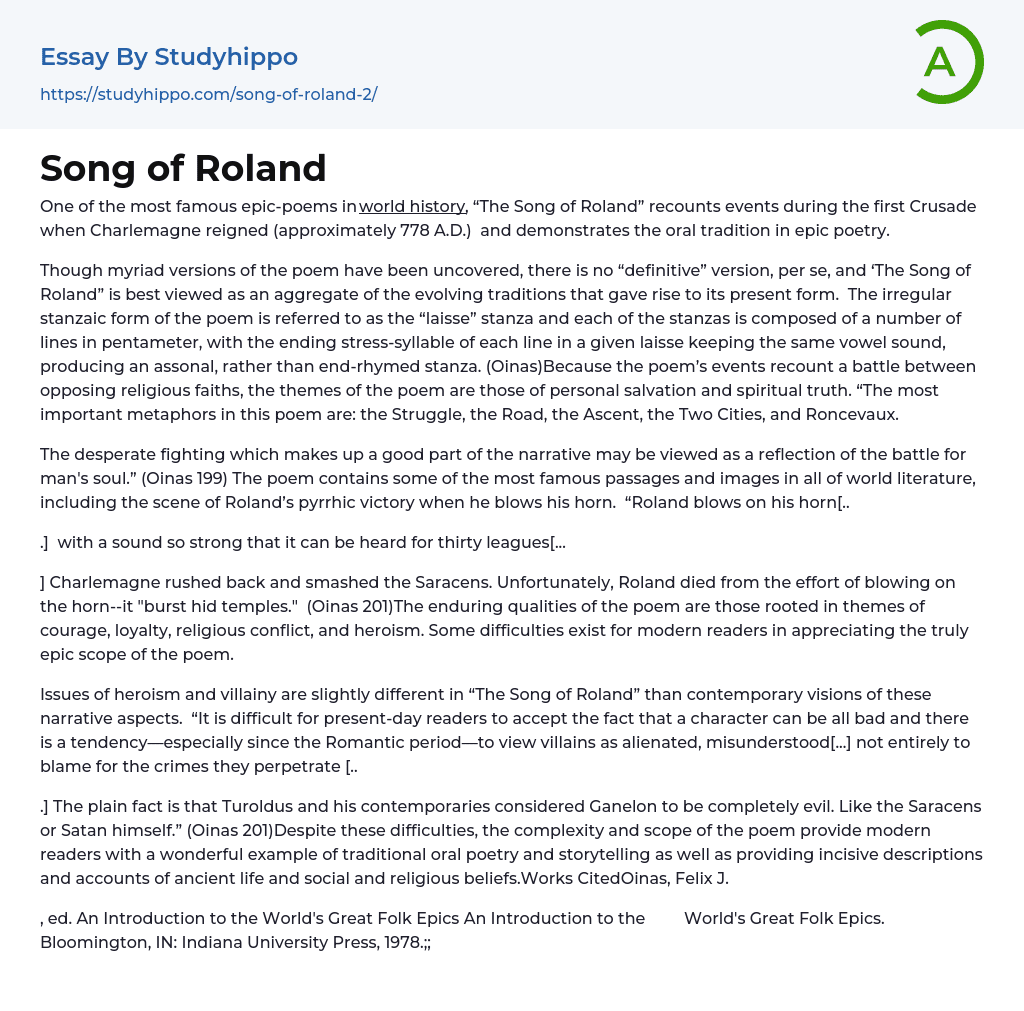"The Song of Roland" is a renowned epic-poem in world history, which depicts events during the first Crusade in the reign of Charlemagne around 778 A.D. This poem showcases the oral tradition utilized in epic poetry.
Although various versions of the poem have been found, it is not necessarily a definitive version, and "The Song of Roland" should be considered a combination of evolving traditions that led to its present form. The poem's irregular stanzaic form is known as "laisse" stanza, where each stanza consists of several pentameter lines with the same vowel sound at the end of each line, creating an assonal stanza rather than an end-rhyming one. (Oinas) Since the poem describes a battle between opposing religious beliefs, its themes revolve around personal salvation and spiritual truth. "The most significant metaphors in this poem include the Stru
...ggle, the Road, the Ascent, the Two Cities, and Roncevaux."
According to Oinas (199), the intense combat depicted in the poem represents the struggle for humanity's inner being. Among the most renowned excerpts in global literature is Roland's pyrrhic triumph, including the moment when he sounds his horn.
...producing a noise of such magnitude that it is audible up to a distance of thirty leagues.
Charlemagne swiftly returned and defeated the Saracens, but Roland tragically perished from the strain of sounding his horn, causing his temples to burst. These themes of bravery, allegiance, religious tension, and valor are what make the poem everlasting, despite the challenges that modern readers may face in fully grasping its impressively grand scale. (Oinas 201)
In "The Song of Roland," the portrayal of heroism and villainy differs somewhat from modern conventions. Contemporary readers
may struggle to accept that a character can be wholly villainous, as there is a prevalent belief, particularly since the Romantic era, that villains are often alienated and misunderstood, and therefore not fully responsible for their nefarious actions.[...]
.] According to Oinas (201), Turoldus and his contemporaries deemed Ganelon to be wholly wicked, akin to the Saracens or Satan. Nevertheless, despite these challenges, the poem's intricacy and expansiveness furnish contemporary readers with a splendid illustration of customary verbal poetry and narrative. Furthermore, it offers insightful portrayals and narratives of bygone eras, societal values, and religious convictions.
, ed. "An Introduction to the World's Great Folk Epics" is a book published by Indiana University Press in 1978.
- Canterbury Tales essays
- Dulce Et Decorum Est essays
- My Last Duchess essays
- Beowulf essays
- Sir Gawain And The Green Knight essays
- The Road essays
- Aeneid essays
- Odyssey essays
- Blackberry Picking essays
- Beowulf Epic Hero essays
- Walk This Way essays
- Song Analysis essays
- John Locke essays
- 9/11 essays
- A Good Teacher essays
- A Healthy Diet essays
- A Modest Proposal essays
- A&P essays
- Academic Achievement essays
- Achievement essays
- Achieving goals essays
- Admission essays
- Advantages And Disadvantages Of Internet essays
- Alcoholic drinks essays
- Ammonia essays
- Analytical essays
- Ancient Olympic Games essays
- APA essays
- Arabian Peninsula essays
- Argument essays
- Argumentative essays
- Art essays
- Atlantic Ocean essays
- Auto-ethnography essays
- Autobiography essays
- Ballad essays
- Batman essays
- Binge Eating essays
- Black Power Movement essays
- Blogger essays
- Body Mass Index essays
- Book I Want a Wife essays
- Boycott essays
- Breastfeeding essays
- Bulimia Nervosa essays
- Business essays
- Business Process essays
- Canterbury essays
- Carbonate essays
- Catalina de Erauso essays




